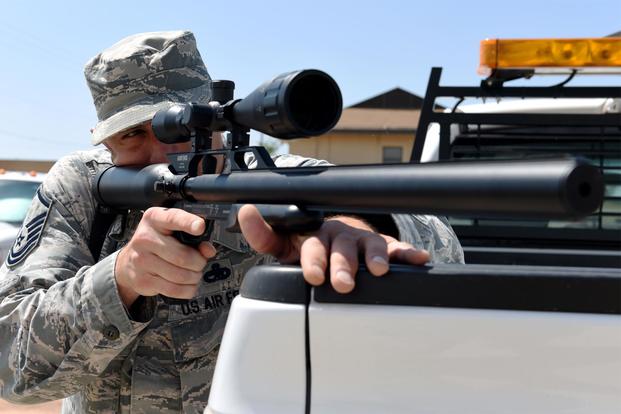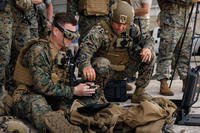If Dan Sullivan could use small drones to keep an eye in the sky over U.S. air bases, he would. But that may be a future strategy to survey wildlife lurking near military airfields, posing a risk to aircraft.
Drones would negate the need for airmen to suit up and wade through swampy areas around bases to look for animals. And "if your drone is equipped with a forward-looking infrared, at night it could pick up deer, hogs, coyotes … and having that drone pick up heat flying around, that would be a great asset for a BASH program," Sullivan, the Air Force's wildlife biologist and the Bird/Wildlife Aircraft Strike Hazard chief, said in a recent interview with Military.com.
While drone use remains debatable in terms of safety and vulnerabilities, Sullivan said there is a growing need for them and other technologies as wildlife finds refuge near installations that house major aviation operations.
But for now, he said, he'll settle for having more airmen trained in spotting bothersome wildlife and how to safely confront it. "I'm looking to institute a more in-depth training [program] here at the [Air Force Safety Center], more for folks that are boots on the ground."
'A Little War'
Sullivan, who oversees the BASH program, which is headquartered at Kirtland Air Force Base, New Mexico, said he sees the "threat" of wildlife increasing because the U.S. has some of the best wildlife conservation programs in the world.
Wildlife encounters accounted for 418 of the Air Force's 5,109 Class A, B and C mishaps from 2011 to 2017, according to a recent independent study from Military Times. The encounters have cost the service roughly $182 million in that time, Military Times said.
Class A mishaps are defined as involving fatalities, severe damage totaling $2 million or more, or a complete loss of the aircraft; Class B, between $500,000 and $2 million in damage, partially disabling the aircraft, or persons involved sustaining minor injuries that may result in loss of work hours; and Class C, between $50,000 and $500,000 in damage to the aircraft, or minor injuries sustained.
A repeat offender? The Canada goose, which has cost the Air Force roughly $94,000 in damages to aircraft between 1995 and 2016, the Times said.
Related content:
- Air Force Launches Aviation Inquiry Amid Reports of Increased Mishaps
- Pentagon Memo Grounds Air Force Special Ops Quadcopters
- Aviation Accident Spike Has Services Scrambling for Solutions
"What's dangerous to a C-17, a large aircraft, is different than what's dangerous to an F-16, a single-engine fighter aircraft," Sullivan said. But "our large [species] of birds are increasing."
Sullivan wants to make sure squadrons have a plan in place to avoid accidents with animals.
His job is to write policy, give technical expertise on whether birds and other wildlife can best be dealt with in lethal or nonlethal ways, and often act as the service's liaison with state governments. He previously worked as a Department of Agriculture Wildlife Services biologist at airports including John F. Kennedy and LaGuardia in New York.
"One of our policies is that any Air Force base that has … any type of flying operations, they must have … a BASH plan," he said.
Sullivan said a new policy enacted in May requires bases to conduct airfield surveys more frequently to keep tabs on what kind of species are entering the area. "By doing surveys monthly, it will tell you if what you're doing now is effective," he said. "Wildlife is challenging, because they learn, they adapt. It's kind of like a little war."
Birds vs. Aircraft
Sullivan in recent months has done research that shows if extra airmen are trained in BASH safety practices, there will be better continuity in the mission, allowing the Air Force to train other airmen as they move between units. He is also trying to get a specialized civilian wildlife manager at more bases to oversee operations in tandem with airmen doing their day-to-day duties.
Their mission is depredation. A small group of airmen will go out and scan the surrounding area as part of the base flight safety check. Flight safety aircrew are also in the watchtower to help flag what they see below.
Per Sullivan's suggestion, some bases keep a conservation wildlife biologist as part of their BASH team to survey the surrounding area on a regular basis.
At Dyess Air Force Base, Texas, Zachary May, the USDA Bird/Wildlife Aircraft Strike Hazard manager, serves as the biologist and surveys the airfield six hours a day. "We monitor what's where in relation to approaching aircraft," he said.
The base has 30,000 aircraft movements -- take-offs and landings -- per year.
May last year joined the flight safety team, which includes Master Sgt. Michael Ottmo, the 7th Bomb Wing noncommissioned officer, and Maj. Jeff Smith, the 7th Bomb Wing chief of flight safety.
"I'm trained that anytime I spot a bird in the traffic pattern to call it out, its location … so that someone from airfield management or the USDA rep can try to get the bird to move and scare it away," Smith said.
The team will watch how the birds or other wildlife behave, and then use the proper techniques to shoo them away before the animals make their nesting habitual.
Zero Tolerance
"My policy is zero tolerance from mammals such as deer, coyote, elk. If they're on your airfield, get rid of them," Sullivan said. "If you can't let them out safely, then you're going to have to remove them lethally." But "the last thing we want to do is kill wildlife," he added.
Large mammals drive up costs, especially in potential damage, he said. To keep them away, vegetation must be kept between seven and 14 inches high and there must be adequate water drainage and fences, among other factors.
Some techniques regularly used to scare animals away include nonlethal pyrotechnic guns, noise makers ("screamers" and "bangers," as Sullivan called them), propane cannons and airsoft guns.
May said shooting the animals is usually the last resort. Poisoning isn't a common practice.
Sullivan said the Air Force must seek permits through various agencies, notably the U.S. Fish and Wildlife Service, to use lethal force. The service encourages working with state agencies before killing certain species, which may be on the endangered list.
"Within that, there are a limited number of birds we can take [out], but we regularly maintain well below that number," May said.
While the Trump administration has mulled rolling back policies that protect numerous species, Sullivan doesn't expect Air Force bases to increase the number of animals killed.
"Even if they did give us [those authorities], we wouldn't do it," he said. "Everything that we've been doing over the past number of years hasn't changed. The Air Force is not going to do anything different."
Look at Species, Not Numbers
Safety Center officials, airfield managers and wing commanders form a bird hazard working group and meet twice a year to discuss needs, restrictions and operations on airfields, Sullivan said.
He said he has been to more than 120 military installations across the globe, and each varies in habitat, climate and species, as well as the amount of funding devoted to the program. The Federal Aviation Administration also has a wildlife hazard management plan, he added.
The Air Force teams are aware bird migration patterns change by season, warning pilots to be on high alert when taking off or coming in for a landing.
Dyess' 317th Airlift Wing reported 15 bird strikes to its C-130J Super Hercules fleet in April, according to a release.
They also try to avoid times of day when birds are more active, such as sunrise and sunset.
"We request that [pilots] minimize all landing and takeoffs in low-level flight in these migratory pathways," Smith said. "We want to limit the number of flights and time spent low to the ground."
The airmen said analysts shouldn't necessarily look at the numbers, but rather the species of bird.
Ottmo said any bird could be catastrophic to an aircraft depending on where it hits, with engine strikes being particularly dangerous. But a B-1 Lancer bomber may take more damage from hitting two ducks than hitting 19 smaller Starlings.
If a bird strike occurs, airmen take a sample of the bird's remains and send it to the Smithsonian Institution Feather ID Lab for testing, Ottmo said, adding that it helps to identify migratory bird species patterns across the U.S.
"When I get that data back from the Smithsonian and I know what kind of bird was hit … I'm able to better manage the airfield to make it less attractive to that species," May added.
The Fish and Wildlife Service, which has its own migratory bird program, collects the data and passes it to other agencies as requested.
New Tech?
Someday, airmen may get technology that could make all this easier.
Additional radars may be able to pick up bird movements. Some bases currently use bird detection radars or an Avian Hazard Advisory System, Sullivan said.
But the systems are costly and are most useful when there's a large flock together for clearer detection, May added.
Drones have potential too. Just gathering data, "the power of prediction will help with the BASH program," Sullivan said.
Until then, as long as nature isn't ignored, everything should co-exist just fine, May said.
"Keep in mind, the mission is to keep the airfield safe for our airmen," he said. "Every day, we just have to be vigilant."
-- Oriana Pawlyk can be reached at oriana.pawlyk@military.com. Follow her on Twitter at @Oriana0214.










